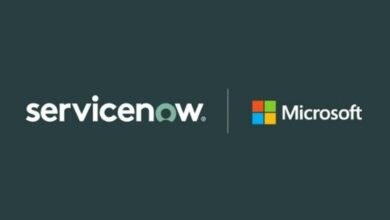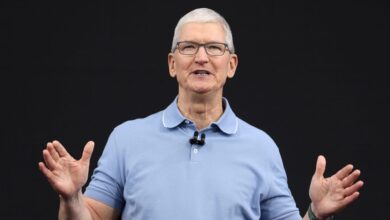The Future Of New Hire On-Boarding Is Embedding Generative AI

Close-up stock photograph showing a touchscreen monitor being used in an open plan office. A woman’s … [+]
As our attention and resources focus on generative AI, (gen AI) one question that keeps coming up for me is how companies can use gen AI to address a persistent pain point, new hire on-boarding. Nearly every company, regardless of size or industry has some process for new hire on-boarding, but Gallup research finds only 12% of new employees strongly agree their organization does a great job on-boarding new hires. That’s 88% who are feeling let down just days or weeks into their new job.
Designing a compelling new hire on-boarding experience can lead to greater employee engagement and satisfaction. Gallup research finds employees who state they have an exceptional new hire on-boarding experience are 3.3 times as likely to strongly agree their job is as good or better than expected.
The result of a poorly conceived on-boarding experience can lead to employee attrition. According to the Society for Human Resource Management (SHRM), employee turnover can be as much as 50% in the first four months for hourly workers and 50% in the first 18 months for senior external hires.
As I think about these research findings, I see an opportunity to re-design new hire orientation to include generative AI, (genAI.) For a growing number of organizations, the new hiring imperative is being literate in using gen AI in one’s job. The 2024 Work Trend Index from Microsoft and LinkedIn finds 77% of leaders say new hires will get greater responsibilities due to their knowledge of how to effectively use gen AI in their job role. In addition, 71% of leaders are more likely to hire a less experienced candidate who has gen AI skills than a more experienced candidate without them. But given the continuing talent shortage do companies really have this choice?
Designing a new hire on-boarding process which incorporates gen AI provides an opportunity to enhance and personalize the on-boarding process. Employees can not only learn about the company culture and values but also how to activate gen AI in an employee’s workflow, ranging from text to image generation, assistance in creative ideation, and analyzing data. One of the immediate benefits of using gen AI in the on-boarding process is to personalize the on-boarding experience, so new hires see communication that is meaningful to them, whether they are Gen Z, Millennials, Veterans, or Working Moms. AI powered solutions are already happening with LinkedIn’s new AI powered tool where users can assess a fit for a new role in seconds or iSpring’s eLearning solution where AI supports quiz generation. According to iSpring’s recent research, most businesses prefer to do their staff training in-house and this means relying on mentors as subject matter experts. This presents an opportunity for AI to assist HR leaders in creating professional learning materials while saving on instructional design fees in the design process. Leveraging the power of gen AI can also support new hires by personalizing the communication and designing quizzes to identify skill gaps and assess knowledge.
Research by Brandon Hall Group finds organizations with a strong onboarding experience improve new hire retention by 82 percent and productivity by over 70 percent. But only 29% of new hires feel supported and prepared to excel in their jobs.
So how can you think about combining your need to re-design your new hire on-boarding experience with including gen AI to enhance this process? My suggestion is the RAPID model developed for training HR team members in AI. This is depicted below:
RAPID Framework for Integrating AI Literacy into On-boarding
This framework starts with the business problem an HR team uncovers and then sets out to identify opportunities to address this business problem while also building gen AI literacy.
Recognize Urgency
HR leaders can start by identifying the problem they are solving for and then collecting data on this problem. In the case of re-designing new hire on-boarding, this can range from addressing a need for greater personalization in the on-boarding process to aligning this process to the needs and expectations of employees in key job roles. In addition, with the expansion of gen AI across organizations, this is also an opportunity to embed gen AI literacy training into the on-boarding experience.
Analyze Insights
Assess the results of your data collection. For example, as I wrote in 13 HR Jobs of the Future, ING collected data on the problem of engaging employees in what they called the pre-onboarding process, the time from accepting an offer to starting a new job. This time can stretch from weeks to months. Sander de Bruijn, Head of Global Employee Experience at ING, addressed this problem by re-vamping the pre-onboarding process to incorporate personalized communications for managers to send to new hires during this time, so they felt welcome even before they started their job.
Plan for AI Literacy
Before designing the new hire on-boarding program, your organization should conduct a comprehensive assessment of your AI readiness and the anticipated future AI needs that employees will need training on. This will guide your design process and ensure that using gen AI in this process will be relevant to the needs of your employees. Think of gen AI as a tool to improve the employee experience and not a replacement for your HR team members.
Identify Activation Plan
Embedding gen AI training into your new hire on-boarding program is only the first step. This training should go beyond what is gen AI and how to create prompts, to how to activate gen AI into employee workflows. This can start by showing new hires use cases for how to incorporate gen AI into creating first drafts of documents or using gen AI to practice having crucial conversations in preparation for a performance review.
Deploy New Solution
As you design the new hire on-boarding program, identifying key metrics will be critical to your success. The key metrics to consider can include fewer resignations in the first 6-18 months, greater speed to competence for new hires, greater satisfaction with the job, greater impact on the business goals and reduction in the amount of post on-boarding support needed for new hires. Interestingly, research from iSpring poses an interesting question, how can the re-design of new hire on-boarding favorably impact the employer brand?
While gen AI will help HR leaders with candidate outreach by performing targeted candidate searches and candidate engagement by personalizing relevant content to job seekers, embedding gen AI into the new hire on-boarding process provides HR leaders an opportunity to favorably impact their employer brand. Candidates should know once they accept an offer, they will be experiencing gen AI training starting on their first day of new hire on-boarding. A recent survey of full-time workers finds 98% want some type of training in gen AI funded by their employer.
While Conference Board research finds 56% of workers are using Gen AI at work with one in ten using gen AI daily, only 26% say their employer has a policy on effective use of gen AI with another 23% saying some policy of using gen AI is under development, but has not been approved yet. By embedding gen AI training into new hire on-boarding, companies can also incorporate gen AI policies in the on-boarding experience.
Building gen AI literacy training and showcasing ways to activate this into new hire on boarding is a powerful way workers can not only learn about the vision, values, and culture of the organization, but also build their gen AI skills. By embedding gen AI training in new hire on-boarding employers can use this as a vehicle for increasing attraction of new candidates and improving employee retention.



